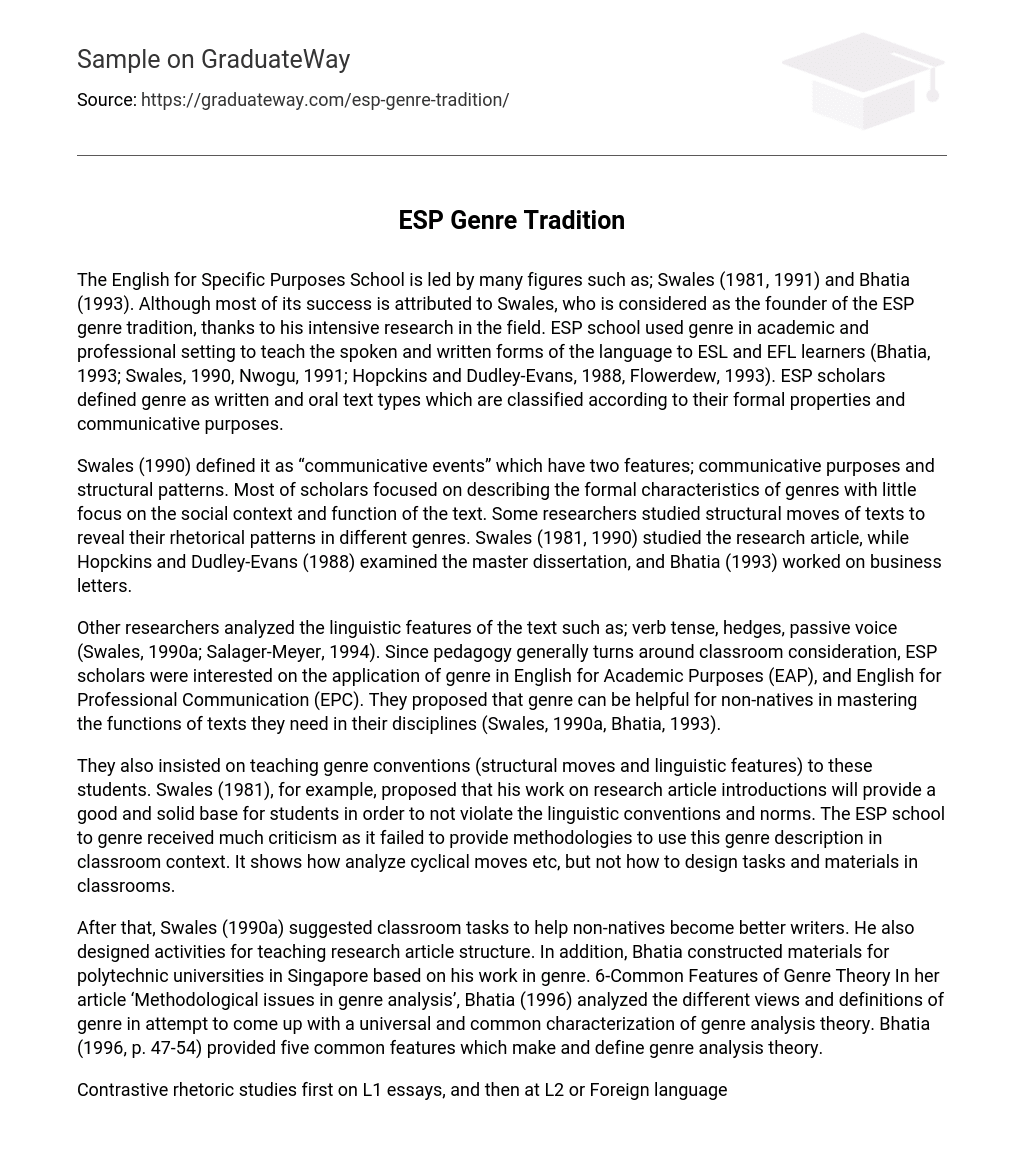The English for Specific Purposes School is led by many figures such as; Swales (1981, 1991) and Bhatia (1993). Although most of its success is attributed to Swales, who is considered as the founder of the ESP genre tradition, thanks to his intensive research in the field. ESP school used genre in academic and professional setting to teach the spoken and written forms of the language to ESL and EFL learners (Bhatia, 1993; Swales, 1990, Nwogu, 1991; Hopckins and Dudley-Evans, 1988, Flowerdew, 1993). ESP scholars defined genre as written and oral text types which are classified according to their formal properties and communicative purposes.
Swales (1990) defined it as “communicative events” which have two features; communicative purposes and structural patterns. Most of scholars focused on describing the formal characteristics of genres with little focus on the social context and function of the text. Some researchers studied structural moves of texts to reveal their rhetorical patterns in different genres. Swales (1981, 1990) studied the research article, while Hopckins and Dudley-Evans (1988) examined the master dissertation, and Bhatia (1993) worked on business letters.
Other researchers analyzed the linguistic features of the text such as; verb tense, hedges, passive voice (Swales, 1990a; Salager-Meyer, 1994). Since pedagogy generally turns around classroom consideration, ESP scholars were interested on the application of genre in English for Academic Purposes (EAP), and English for Professional Communication (EPC). They proposed that genre can be helpful for non-natives in mastering the functions of texts they need in their disciplines (Swales, 1990a, Bhatia, 1993).
They also insisted on teaching genre conventions (structural moves and linguistic features) to these students. Swales (1981), for example, proposed that his work on research article introductions will provide a good and solid base for students in order to not violate the linguistic conventions and norms. The ESP school to genre received much criticism as it failed to provide methodologies to use this genre description in classroom context. It shows how analyze cyclical moves etc, but not how to design tasks and materials in classrooms.
After that, Swales (1990a) suggested classroom tasks to help non-natives become better writers. He also designed activities for teaching research article structure. In addition, Bhatia constructed materials for polytechnic universities in Singapore based on his work in genre. 6-Common Features of Genre Theory In her article ‘Methodological issues in genre analysis’, Bhatia (1996) analyzed the different views and definitions of genre in attempt to come up with a universal and common characterization of genre analysis theory. Bhatia (1996, p. 47-54) provided five common features which make and define genre analysis theory.
Contrastive rhetoric studies first on L1 essays, and then at L2 or Foreign language writings contributed a lot in the improvement of research in the field of writing studies. As Kaplan (1966) raised the question of L1 influence on L1 writing, he motivated many scholars, teachers, educators, and researchers to dig deeper in the field and examine more samples to unveil the reasons behind students’ failure at L2 or FL writing. Such new directions led to the study of intercultural differences among different languages from different origins. Together with Genre theory, contrastive rhetoric examined discourse (oral/written) in different discipline and from different languages. The basic principles





